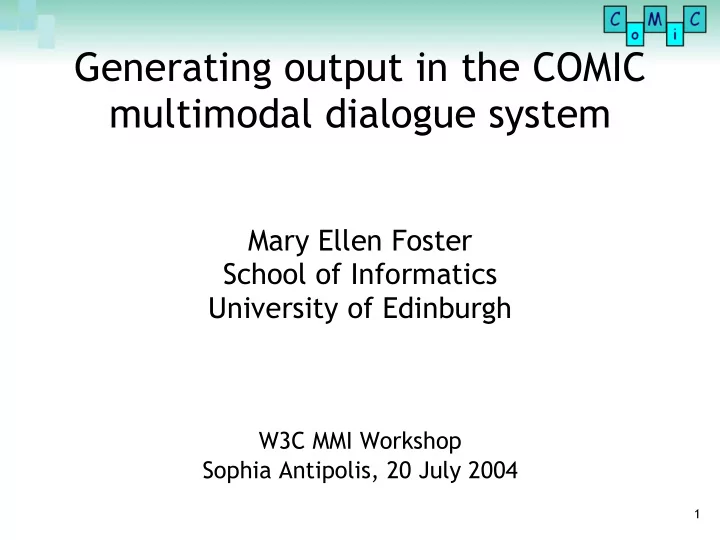

Generating output in the COMIC multimodal dialogue system Mary Ellen Foster School of Informatics University of Edinburgh W3C MMI Workshop Sophia Antipolis, 20 July 2004 1
Overview The COMIC project and demonstrator Planning and generating output in COMIC Multimodal fission in COMIC Planning text, gestures, and facial expressions Speech synthesis and output coordination System evaluation Next steps for fission 2
COMIC: “COnversational Multimodal Interaction with Computers” EU FP5 project: March 2002-Feb 2005 Goal: apply results and models from cognitive psychology to multimodal dialogue Demonstrator: adds a multimodal dialogue interface to a CAD-like system for bathroom design 1. Specify shape of bathroom (2. Place furniture) ➢ 3. Browse available tiles 3
Input processing and dialogue management Speech recognition and NLP Handwriting and (pen-)gesture recognition Multimodal fusion Dialogue manager Dialogue history manager, ontology manager 4
Fission and output processing ➢ Fission module (presentation planner) Speech synthesis (Edinburgh) Surface realiser: OpenCCG (White, 2004) Speech synthesiser: Festival, unit selection “Talking head” avatar Bathroom-design application 5
Sample interaction (browsing tiles) COMIC: [Introduction] ... “Are you ready?” User: “Yes.” COMIC: [Describes tiles on screen] ... “Please choose one.” User: “Show me this one.” [Circles second design] COMIC: [Chooses and describes tiles] ... “Do you want to see more modern designs?” ... etc. ... 6
Fission inputs and outputs Realizer and Synthesizer ● Logical forms ● Canned text Avatar Dialogue acts Dialogue ● Phonemes FISSION manager ● Emphasis commands Application ● Expressions commands ● Gaze directions ViSoft application ● Phase switches ● Choosing tile sets ● Pointer commands 7
Fission tasks Content selection and structuring Elaborate the high-level specification from the dialogue manager Modality selection Decide on the content to be produced on each channel Output coordination Ensure the output is coordinated temporally and spatially 8
Sample output plan DAM input: show(tileset21), describe(tileset21) Turn Acknowledge Choose tile set Describe tile set [nod] “Okay.” “This design “It uses tiles [...] is classic.” from ...” Sequence Immediate command Sentence 9
Creating and executing an output plan Create initial high-level structure based on DAM specification Elaborate and then output children in order Planning and execution are interleaved; later children in preparation while output is being produced from earlier ones Avoid adding to (already non-trivial) latency 10
Text planning with XSLT (non-canned text) Gather information from system ontology; filter based on dialogue history; put in order Combine adjacent messages when possible Create a logical form (with alternatives) for each message and send it to the realiser Details: M E Foster and M White. Techniques for text planning with XSLT . NLPXML-4 Workshop, 25 July 2004, Barcelona. 11
Speech synthesis Voice: general-purpose unit selection, with in-domain recording scripts Realiser output includes intonation, but current voice can't support it (stay tuned!) <?xml version ="1.0" encoding ="UTF-8" ?> <!DOCTYPE apml SYSTEM "apml.dtd" > <apml> <performative> <emphasis x-pitchaccent ="Hstar">This </emphasis> <emphasis x-pitchaccent ="Hstar">design </emphasis> is <emphasis x-pitchaccent ="Hstar" > classic </emphasis> <boundary type ="LL" /> . </performative> </apml> 12
Speech timing Speech timing determines presentation timing Coordination achieved by adding labelled spans to the input of the speech module <seg id="123"> <speech id="123"> <words> <speech> <word id="w0" start="0.018750" end="0.334000" content="Hello"> Hello <phoneme id="p0" start="0.018750" end="0.101750" content="h"/> <span label="ww"> <phoneme id="p1" start="0.101750" end="0.114000" content="@"/> world <phoneme id="p2" start="0.114000" end="0.194563" content="l"/> </span> <phoneme id="p3" start="0.194563" end="0.334000" content="ou"/> . </word> <word id="w1" start="0.334000" end="0.819688" content="world"> </speech> <phoneme id="p4" start="0.334000" end="0.445750" content="w"/> </seg> <phoneme id="p5" start="0.445750" end="0.511813" content="@@r"/> <phoneme id="p6" start="0.511813" end="0.577188" content="r"/> <phoneme id="p7" start="0.577188" end="0.730187" content="l"/> <phoneme id="p8" start="0.730187" end="0.819688" content="d"/> </word> </words> <spans> <span type="labelled" info="ww" start="w1" end="w1"/> </spans> 13 </speech>
Planning pointer “gestures” Mark NPs in input with on-screen referents, and choose gestures and offsets for some subset Use application screen state to find objects Two versions: rule-based, or corpus-based Evaluation (just completed): forced choice between two versions; justify choice where possible Details: M E Foster. Corpus-based planning of deictic gestures in COMIC . INLG-04 (Student Session), Brockenhurst, 14-16 July 2004. 14
Facial expressions, gaze, and emphasis Expressions and gaze: only between sentences Phonemes: extracted from speech- synthesiser timing Emphasis commands: based on pitch accents 15
Output sequencing and coordination Sequences: Traverse subtree in order, waiting for any nodes that are not ready yet Immediate commands (expressions, gaze, screen-state changes) : send command, wait for “done” report Sentences: Send text to synthesiser (canned or via realiser) Send timing to avatar; prepare gestures Send “go at time t ” + concrete gesture schedule 16
System evaluation Subjects use system for 15-20 minutes Conditions: full face or “zombie” Measures Recall of information presented (task success) Subjective user-satisfaction questionnaire Objective measures from log files Just completed (37 subjects); no results yet Evaluation of room-drawing phase pending 17
Next steps for fission Incorporate ideas from centering theory into text planning (Kibble & Power, 2000; Karamanis, 2003) Refer to a user model throughout the generation process (Moore et al., 2004) Holy grail: instance-based multimodal generation Gather good instances by having users rate various combinations (as in current gesture evaluation) Use (upcoming) factored language models in OpenCCG to choose among cross-modal alternatives 18
W3C standards Currently in use XSLT, XPath: for text planning (NLPXML paper), plus many other stylesheets used internally Possible additions SMIL: not for serialisation; possibly for internal data structures SSML: if the synthesiser supports it EMMA for output? Find out more (EMMA for input? can't comment) 19
References http://www.hcrc.ed.ac.uk/comic/ http://www.iccs.inf.ed.ac.uk/~mef/ 20
Recommend
More recommend